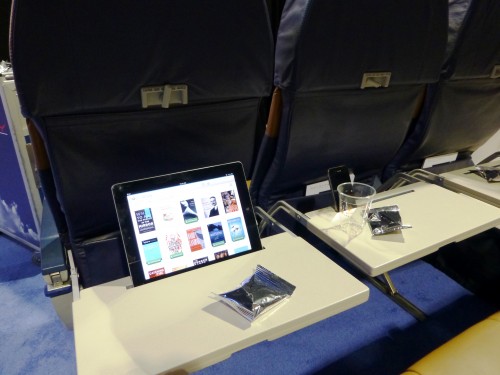While a short promotional movie called Howdy Chicago was shown to passengers on an plane that flew over the Chicago World’s Fair in 1921, there were no regular in-flight movies until 1961, when Trans World Airlines (TWA) began offering that novel perk to its first-class customers.
Video games (1975), seat-back video (1991) and live in-flight television (2000) followed, and today passengers in all classes, on both long and short haul flights, have come to expect some sort of airline-provided, in-flight entertainment.
And they get it. Often on personal, seat-back multi-channel systems that deliver everything from creatively produced safety videos to movies, games, live television, shopping opportunities and, increasingly, access to the internet.
But tech-savvy passengers toting tablets, laptops, smartphones, e-readers, and other portable electronic devices are giving airlines and the traditional in-flight entertainment systems a run for their money. This has forced providers to re-think how they use technology to entertain and interact with passengers in the sky.
I got a good look at how that process is evolving earlier this month in Long Beach, Calif., when I served as one of the judges for an award given out by the Airline Passenger Experience Association (APEX) at its annual expo. The event also featured educational sessions about the wide variety of technological changes coming to in-flight entertainment systems, plus a giant hall filled with exhibitors representing products, services and content you may experience on a future flight.
Breaking down all the tech-talk , the good news is that from the latest movies and games to documentaries, kids programming and health and wellness videos, there will be no shortage of in-flight entertainment options. Seat-back screens and systems are unlikely to go away, and in fact they may soon get even snazzier, with high definition, 3-D movies and games, and even holographic offerings on the horizon. But airlines are also scrambling to work out how to deliver that same programming, plus Wi-Fi, streaming and internet-delivered content, to travelers on their own or airline-provided devices.
For example, JetBlue just announced that in early 2013, it plans to offer free in-flight Wi-Fi, with plans to equip 30 planes with what it promises will be super-fast service. After that, checking e-mail and touring the internet should remain free, but there will be a fee for watching films.
Delta Air Lines also recently announced plans to upgrade its Wi-Fi equipped airplanes and offer passengers the ability to stream programming directly to their personal devices using a service called Gogo Vision. Fees for that programming will start at $.99 for TV shows and $3.99 for full-length movies. And here’s a nice touch: If you don’t finish watching something on the plane or want to download another program to watch at home or in your hotel later, you’ll have access to that material on that same device (if you’ve got access to the internet) after your flight for 24 hours. Look for that on 800 of Delta’s two-class domestic aircraft by the end of 2013.
Of course, accessing all this programming on your personal electronic devices means you’ll be asking your batteries to give it their all, unless you’re lucky enough to have a (working) USB port or power outlet at your seat. And that brings up another issue: Will airlines add the juice to power devices to the menu of items for sale in-flight?
Don’t be surprised if it comes down to that. The airline industry already earns more than $32 billion a year in ancillary revenue from ‘unbundled’ services such as baggage fees, change fees, in-flight meals and Wi-Fi, and in one of the expo workshops a presenter pointed out that airlines have a “prime opportunity to monetize the onboard experience” because passengers are easily influenced on board and “have a higher propensity to spend.” So if you’re going to spring for the movie, perhaps you’ll won’t mind paying a bit more to make sure you’ll be able to watch that movie the entire way through.
Not everything on view in the Expo exhibition hall was super high-tech.
Recognizing that so many passengers now travel with their own tablets, e-readers and other portable electronic devices, Smart Tray International was there to introduce a tray table with what seemed to be a common-sense, built-in groove for holding those devices upright.
And while Uplifted, a fitness company from Perth, Australia, had rented a booth in hopes of selling airlines a nicely-produced exercise video that mixed in moves from yoga, Pilates and Tai Chi that passengers can do at their seats, company founder Sally Dollas also had a stash of instructional workout pamphlets on heavy paper that were a snap to hang on the latch of an upright tray table.



